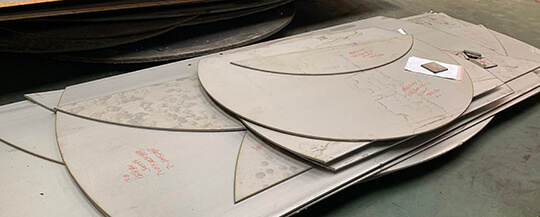The key process description of the trial forming of the duplex stainless steel composite plate head of the high-pressure gas-liquid separator with an inner diameter of 1600mm, a wall thickness of (4+80)mm, and a straight side height of 50mm, with a material of 2205+16MnR:
(1) Order thickness of steel plate: In order to ensure that the minimum thickness after forming the head meets the design requirements, a thickness reduction of not less than 10% should be considered. Generally, the thickness reduction of the base layer is mainly considered. The thickness specification of the head steel plate this time is (4+90) mm.
(2) Incoming inspection of raw materials: Full performance inspection shall be carried out in accordance with the above-mentioned "1 Head Material Performance Requirements", with special emphasis on the 100% ultrasonic inspection of the base layer and the cladding layer and the vicinity of the groove surface. qualified.
(3) Head blanking: The blanking size of the head is determined based on the form of the head, the height of the straight side section and experience. The diameter of the billet is generally: the inner diameter of the head 1600×1.2 + the height of the straight side 50×2+2×20 The margin is 2060mm.
(4) Steel plate heating: The heating temperature of the composite steel plate entering the furnace should be higher than 475℃, and the holding time is determined according to the thickness. After the head steel plate is kept warm for 1.5 to 2 hours, it is heated to 950℃ and released.
(5) Initial press forming: In the pressing workshop, the distance between the heating furnace and the press forming machine should be shortened as much as possible. The high-temperature steel plate out of 950℃ is quickly sent to the press forming machine for press forming. Ensure that the initial pressure temperature of the head is 950℃ and the final pressure temperature shall not be lower than 800℃ during the forming process.
(6) Cooling and shaping: The pressed and shaped seal is inverted on the flat plate like a bowl, and it is naturally cooled and shaped in the air. It usually takes 24 to 48 hours to ensure that it is cold. According to JB 4746, the appearance size and surface quality are qualified, and the head is naturally cooled and shaped.
(7) Performance recovery treatment: Although the outer dimensions of the formed head meet the requirements at this time, the mechanical properties and corrosion resistance of the cladding generally cannot meet the requirements. Solution treatment must be carried out to make the mechanical properties and corrosion resistance of the cladding Sexual recovery.
Secondary heating: Put the cold head into the furnace at 1020~1050℃, keep it warm for 20 minutes, and then come out of the furnace, and quickly transport it to a special water-cooled platform with a forklift.
Water-cooled platform: The water-cooled platform is a hollow bracket made of welded steel, with a spherical nozzle installed in the middle, and a belt controlled by a valve.
The pressurized water is evenly sprayed to the inner surface of the head through the spherical nozzle.
Solid solution water cooling: After the solid solution heated head is quickly sent to the water cooling platform, immediately open the spherical valve to restore the heating head.
The inner surface of the layer is cooled by omnidirectional and full-area spray water. It is advisable to have liquid water flowing down for 4 to 5 seconds. The amount of water is determined by calculation, and the head is solid-solution heated and cooled by water.
Infrared thermometer is used for temperature monitoring throughout the process, and time and temperature changes are strictly recorded. When the cladding temperature drops to about 400℃, stop spraying water to prevent the internal surface cladding temperature from rebounding and ensure that the internal surface cladding temperature is lower than the material embrittlement temperature. Generally, the temperature rebounds from about 20 to 40℃, and then it is naturally cooled to room temperature.
(8) The product test board is made with the furnace, and the full performance test is qualified. Mainly according to the design requirements in the preceding section 1.3, the main mechanical properties of the base material, the composite material and the bonding surface of the formed product and the corrosion resistance of the composite are tested.
Because 2205 duplex steel is very easy to produce brittle phases during the heating process at 475-850℃, it seriously affects the mechanical properties and corrosion resistance of duplex steel, and endangers the safety of equipment. The mechanical properties and resistance of formed products are affected in the construction drawings. Corrosion performance is clearly defined. Therefore, how to ensure the reliability of the forming process of the duplex steel composite plate thick seal head and ensure the corrosion resistance is the key technology of the head forming. The key to the forming of thick-walled duplex steel clad plate heads: the art and production plan are elaborated, which provides important guidance for the smooth press forming of similar stainless steel clad steel plate heads in the future, ensuring product quality, construction period and yield rate. significance.
